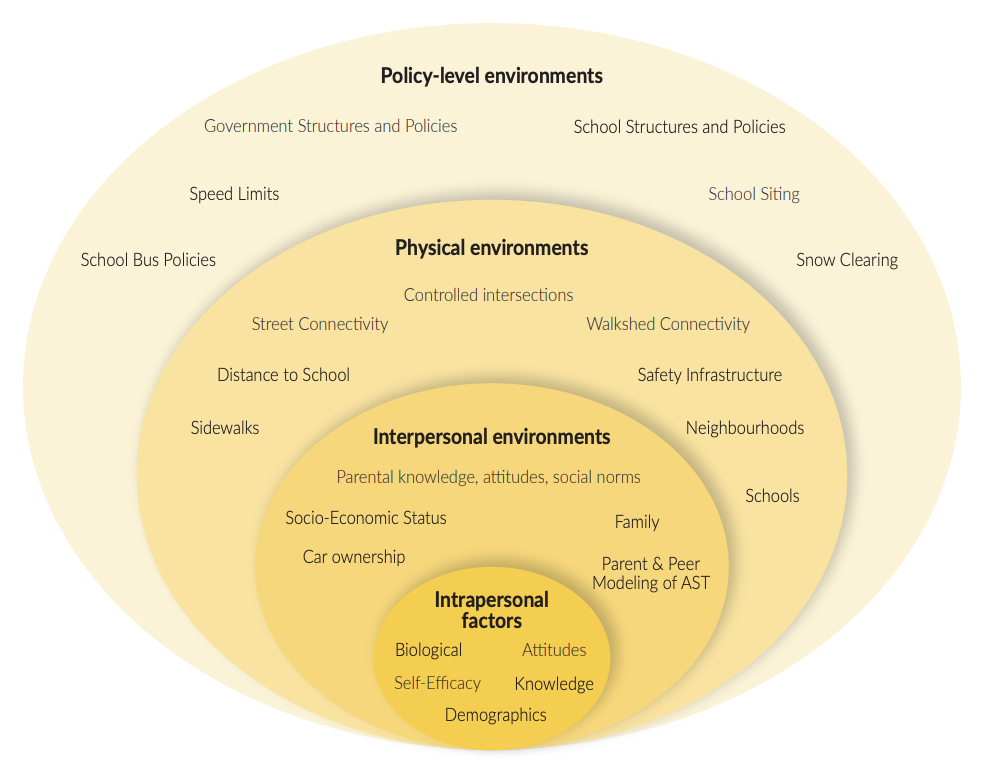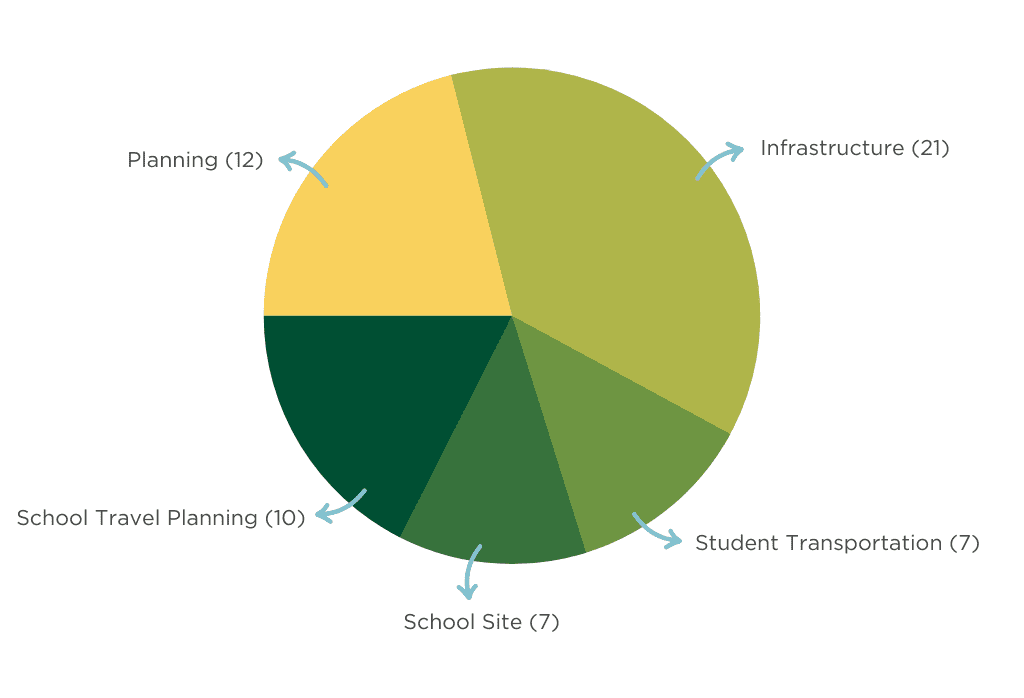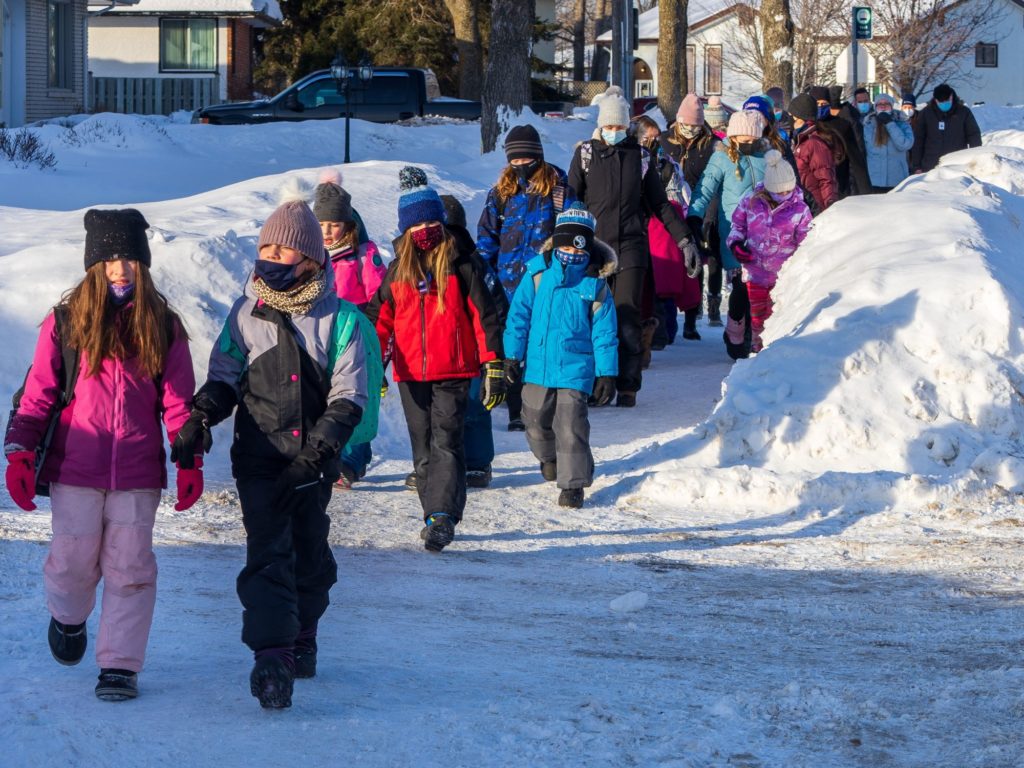Why is it that the majority of Canadian children travel by car to get to school, rather than walking, biking or taking the school bus?
We know from our School Travel Planning work in Canadian communities that there are a myriad of factors at play, including human factors like social attitudes, knowledge and skills, working-parent schedules, perceptions of safety, as well as infrastructure considerations, such as the location of a school and the presence of sidewalks, protected cycle lanes, and crossing guards.

Adaptation of socio-ecological model, showing factors that influence children’s school travel behaviour.
Influencing all of these contributing factors is our public policy – the rules, guidelines, bylaws and strategies that shape our neighbourhoods and our transportation options. Currently, many policies still reinforce driving as a dominant mode of transport, which directly thwarts children’s abilities to safely walk, bike, or roll to school and around their neighbourhood. Child active transportation needs to be supported through relevant provincial and local policies addressing education, transportation, and land-use. Additionally, many of these policies need to be better aligned with each other and foster collaboration between school boards and municipalities.
If we could change existing policies to encourage sustainable mobility for children and increase rates of active school travel, what would we recommend?
Research Scope
To answer this question, Green Communities Canada (GCC) partnered with the Human Environments Analysis Laboratory (HEAL) at Western University to develop evidence-based policy recommendations for schools, school boards, municipalities, and the provincial government. The findings of the research project are detailed in our report ‘Investigation of Supportive Policy for Active School Travel’.
The research identified 57 recommendations across 5 key themes in which relevant policies could be implemented, including Planning, Infrastructure, School Site, Student Transportation, and School Travel Planning.

Pie chart showing a breakdown of the recommended policies across each of the five key policy themes.
Each section of the report explores relevant literature, summarizes existing policies and best practices, followed by a list of recommendations of policy statements. In addition, as a handy navigation tool, Appendix A of the report provides a listing of the primary authority and level of policy associated with each policy recommendation.
The research report demonstrates the critical role of policies and procedures in supporting and promoting active mobility and has been created to provide guidance for relevant decision-makers in the development of policies across communities.
Methodology
Due to the complex nature of active school travel which involves multiple stakeholders in both planning and education sectors, a holistic approach was required to assess multiple governance levels across jurisdictions. The research team used a multi-method strategy that comprised a literature review of 185 academic journal articles, environmental policy scans of 24 regions in Ontario, and 555 key informant surveys and interviews. In addition, the research team held consultations with policy experts to socialize the policy recommendations.
Policy Recommendations
Planning (12 recommendations)
Municipal planning can support active school travel in many ways, including land-use design, traffic control, infrastructure, and school siting. The Planning section outlines policies that can support sustainability initiatives related to transportation mode shift, support connectivity and accessibility through network design, and planning schools for close proximity to children’s homes. The Planning policy recommendations fall into three themes: 1) Planning for Sustainability, 2) Planning Active Transportation Connections, and 3) School Location Planning.
Some key recommendations from the Planning section of the report include:
- A.2.3 Incorporate the NACTO All Ages & Abilities design standards to build communities that are accessible to the entire population. Cycling routes and other active transportation networks should prioritize schools as key origin-destination nodes.
- A.2.4 Establish a new designation of ‘Active School Travel Zone’ to create a framework for prioritizing roads and paths that are important routes for children in a community to access their school by active modes.
- A.3.1 Prioritize keeping schools in locations with appropriate walking and biking infrastructure open, as they are important community hubs and foster increased active school travel.
Infrastructure (21 recommendations)
The built environment can greatly impact the accessibility and perceived safety of school travel routes. Infrastructure changes can help to mitigate perceived traffic safety concerns, such as protected intersections, traffic calming, and separate mobility lanes/paths. The infrastructure policies are organized into nine themes: 1) Complete Streets, 2) Cycling Routes, 3) Bicycle Parking, 4) Street Parking, 5) Use of Sidewalks, 6) Pedestrian Infrastructure, 7) Vehicle Speed and Traffic Calming, 8) Road Safety Education, and 9) School Crossings and Guards.
Some key recommendations from the Infrastructure section of the report include:
- B.4.3 Foster collaboration between schools and municipalities in the implementation of parking programs that encourage driving families to drop-off children farther from the school, such as ‘Drive to 5’, ‘Park & Stride’, & ‘Walk a Block’.
- B.5.1 Allow children 13 years of age and under to bike, skateboard, scooter, & rollerblade on any sidewalk.
- B.6.5 Provide snow clearing on sidewalks, multi-use paths, bike lanes, and cut-throughs to ensure they are accessible year-round. Active School Travel Zones should be prioritized for snow clearing.
- B.7.4 Restrict cars from entering streets immediately beside a school during the normal morning drop-off and afternoon pick-up times. Exceptions should be made for emergency responders, school buses, and caregivers of children with special needs or mobility limitations.
- B.8.1 Develop a School Crossing Safety strategy through collaboration between municipalities and School Boards to ensure safety improvements and Crossing Guards are provided where needed and are prioritized in locations of greatest need. Review ‘School Crossing Strategy’ every 5 years to account for changing infrastructure and needs.
School Site (7 recommendations)
The school location choice and site design can connect to planning and infrastructure policies in support of active school travel. For example, school sites should be accessible from multiple entrances by developing a network of connective paths and the site design should consider limiting drop-off and pick-up locations. The School Site policies pertain to 1) School Site Design, 2) Parking and Drop-off Facilities on School Sites, and 3) Safe Arrival.
Some key recommendations from the School Site section of the report include:
- C.1.2 Provide sufficient, accessible, and secure bike storage at all school sites in a safe, visible location using the Association of Pedestrian & Bicycle Professionals Bike Parking Guidelines.
- C.2.2 Avoid installation of new ‘Kiss & Ride’ facilities to discourage driving children to and from school.
- C.3.2 Develop a ‘Traffic Management Plan’ for each school, working in collaboration with the municipality to create a safer arrival and dismissal experience for students and families accessing the school site.
Student Transportation (7 recommendations)
School Boards govern policy and procedures related to student transportation services, with oversight and funding from the provincial government. Policy such as school bus service eligibility criteria can play a significant role in influencing travel choice. To support active and sustainable modes, policies should be considered for zoning criteria, bus stop locations, and idling in school zones. Such policies are broken down into sub-categories of 1) Vehicles, 2) School Bus Stop Location, and 3) Walking Distance Criteria.
Some key recommendations from the Student Transportation section of the report include:
- D.1.2 Move away from using the term ‘bus eligibility’ and establish new definitions for ‘walk zone’, ‘school bus zone’, and ‘out of catchment zone’ with all students falling into one of these three categories.
- D.2.1 Establish provincial standards for location of school bus stops, to include maximum distance from home and measures to provide safety and comfort for children using stops.
- D.3.1 Establish provincial standards for the ‘walking distance’ beyond which a student qualifies for school bus transportation.
- D.4.1 Investigate the implementation of electric/hybrid school buses and vehicles to decrease carbon emissions created from school travel and to decrease pollution children are exposed to while traveling to school.
School Travel Planning (10 recommendations)
The School Travel Planning framework considers the individual and environmental factors influencing school travel to facilitate multi-sectoral collaboration. To implement School Travel Planning effectively, support is needed from a broad range of public stakeholders including the municipality, school boards and public health units. The ten policies recommended relate to 1) Funding & Partnerships, and 2) Education & Encouragement.
Some key recommendations from the School Travel Planning section of the report include:
- E.1.3 Encourage partnerships/collaborations between municipalities and School Boards in a community (e.g., Active School Travel Charter) to ensure they work together on common goals to support active school travel and school travel planning.
- E.2.1 Develop and/or implement pedestrian and cycling skills training so that all students gain a basic competency in these important life skills.
- E.2.3 Develop school board-wide encouragement and education campaigns to promote active school travel.

Students in Thunder Bay, ON participating in Winter Walk Day event (Photo by: Jesse Milani via EcoSuperior)
Moving Policy Forward
We encourage policy makers to read the ‘Investigation of Supportive Policy for Active School Travel’ report to explore the recommendations in greater detail and consider opportunities for local implementation.
Following on from the release of the research report, GCC is working with HEAL and The Centre for Active Transportation (TCAT) to develop policy advocacy assets that will help policy makers to understand and apply the research findings. Outputs of this next stage of work will include Briefing Notes curated for specific policy makers (school boards, municipalities, provincial government), a consolidated Environmental Scan data set, policy advocacy assets for municipalities and school boards, and a series of information webinars.
GCC and our project partners will continue to share the policy assets as they become available. To stay in the loop about this and other projects, we encourage you to follow @OntarioAST and @GCCCanada on Twitter and sign up for the OAST News newsletter.
Acknowledgements
Thank you to the team at HEAL for leading the research, and the Ontario Active School Travel Council for their advice and guidance on the project. We would also like to thank the many study participants for providing their feedback in the survey and interviews.

The project is aligned with GCC’s Strategic Plan by supporting our members’ advocacy efforts (goal 1), leading effective advocacy efforts (goal 1), and evolving supports to meet emergent needs and expand impact (goal 2).
The policy research project was made possible through financial support from Green Communities Canada, the Government of Ontario, and Mitacs.
Feature photo by: Dan Garrity Media during Bike to School Week via EcoSuperior

Trackbacks/Pingbacks